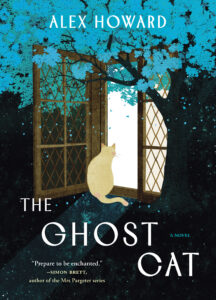 The Ghost Cat by Alex Howard
The Ghost Cat by Alex Howard Genres: Fiction, Historical Fiction, Magical Realism, Time Travel
Published by Hanover Square Press on August 2, 2023
Format: eBook
Pages: 193

A charming novel for fans of Before the Coffee Gets Cold and How to Stop Time , following a cat through his nine lives in Edinburgh, moving through the ever-changing city and its inhabitants over centuries.
Early morning, 1902. At 7/7 Marchmont Crescent, Eilidh the charlady tips coal into a fire grate and sets it alight. Overhearing, Grimalkin the cat ambles over to curl up against the welcome heat and lick his favorite human's hand. But this is to be his last day on earth…before he becomes the Ghost Cat.
Follow Grimalkin as he witnesses the changes of the next 120 years, prowling unseen among the inhabitants of an Edinburgh tenement while unearthing some startling revelations about the mystery of existence, the unstoppable march of time and the true meaning of feline companionship.
In 1902 at 7/7 Marchmont Crescent in Edinburgh, there is a sophisticated, yet elderly tabby cat named Grimalkin who spends his days observing the estate’s owner Mr. Calvert and his devoted maid Eilidah. Full of aches, pains and an itchy patch caused by fleas, one morning Grimalkin takes his last breath and is greeted by the mythical Cat-sith who informs him that as a cat, he has nine lives. Of those nine lives, cats have three lives when they stay, three when they stray, and three when they play. Having spent his first life “staying” and being cared for by Eilidah, Alex Howard’s The Ghost Cat takes the reader along on Grimalkin’s next eight ghostly lives and observational visits at 7/7 Marchmont Crescent and its various occupants over the course of the next one hundred and twenty years. Quietly curious and casually unhurried, The Ghost Cat is a unique historical fiction novel written from the perspective of a senior inquisitive cat that is simultaneously light-hearted while also being thought-provoking.
While the title The Ghost Cat and its premise gives the book a fantasy sound at a first glance, the novel is instead almost entirely a historical fiction book with very little fantasy elements apart from the folklore inspired Cat-sith and Grimalkin’s existence as a ghost across time. While Grimalkin cannot be seen or detected by those he is observing (each chapter amusingly being referred to by “Haunting No.”, followed by the year) and can pass through walls and objects as a ghost, the novel’s main focus is on the historical events that transpire in Edinburgh from a cat’s eye. After his encounter with the Cat-sith, Grimalkin sequentially observes a wide range of events including the creation of a famous literary piece, discussions over modern medicine, second-hand experiences of the World Wars, even the colorful vibes of the 60s and the Beatles. Like other similar books the publisher compared this novel to, The Ghost Cat doesn’t really have a distinctive narrative story, instead choosing to present a collection of vignettes and time capsule like snapshots of history. I’ve read both books specifically mentioned, Toshikazu Kawaguchi’s Before the Coffee Gets Cold and Matt Haig’s How to Stop Time, but Alex Howard’s work is easily the most casual and cozy of them all. Despite certain serious references to toxic chemicals, evacuations during wartime, or even global pandemics, the novel is consistently relaxed, nonchalant and observing rather than being emotionally connected or involved. This type of approach and the lack of a strong overarching story are likely sticking points that will make or break this book for most readers, but I personally found it to be clever and refreshingly unique to read.
It goes without saying that the cat perspective is the main draw and hook for the novel (booktok and bookstagram readers, this one is for the “Features a cat” category!), and there’s quite a bit of cat frolicking, stalking, and other feline shenanigans to entertain. But the novel’s best asset is Grimalkin himself and his comically befuddled thoughts on the changing times. Howard’s character writing is well done and portrays Grimalkin as a senior, Scottish Victorian-era gentleman in cat form and his narration is a constant delight. The humor is very low-key with hints of irony and satire, which perfectly matched my personal taste. Outside of Grimalkin’s character narration, Howard’s prose has an air of sophistication to it while still having moments of poetic beauty and maturity perfectly fitted for a character experiencing life in their twilight years. Compared to other novels it has been compared to like Before the Coffee Gets Cold, Howard’s prose and lyricism is at a much higher level:
Finally, some minutes later, there was that last flicker of sunlight on the floorboards, one last gust of wind, a last scuffle of footsteps and the last chime of a birdsong that coincided with *redacted* time on this earth. And all the spirit, passion and longing that accompanied *their* body on this mortal coil slipped away and were no more.
*Original passage adjusted to avoid spoilers.
To suffer in silence is one thing; but to feel in silence… to miss and crave and love in silence… these were emotions that would rend the heart of any living being.”
While I found the book’s creativity impressive and I got a lot of mileage reviewing this novel from a literary standpoint, there were a few notable points that kept me from completely loving it from a casual enjoyment standpoint. While I don’t believe every novel needs to have a strong story to be successful, The Ghost Cat’s overall structure was a bit underwhelming to me. The first four hauntings are very historically focused chapters, and I found the novel to be at its best when it featured and focused on real historical figures or notable events in history (some of these historical elements pleasantly caught me by surprise, fully revealing the figure or event just as the haunting concludes). As the novel progressed and Grimalkin’s observed more modern years, the historic elements became vaguer and more generalized, lacking the earlier hauntings’ distinctive tones and compelling material. To Howard’s credit, more recent years are inherently more difficult to recapture considering older readers were alive to experience them themselves and there are generally less prominent figures that could feasibly fit into the novel’s restrictive setting and limited scale. The earlier chapters also benefitted from featuring familiar constants, like Grimalkin’s caretaker Eilidah who is the heart and soul of the novel, while the back half of the story doesn’t have as many strong connections by comparison. The connection to past hauntings in his 1990s observation was great but the haunting directly after was quite weak and far too short compared to the other lives in my opinion. Additionally, I felt there were some pacing issues where the last three “play” hauntings were lacking in strong narrative material while also feeling rushed. Grimalkin himself goes from feeling energized and mischievous in haunting six, followed by a wistful 180 shift that almost resembles melancholy. I liked the idea and direction Howard was going with the character writing but felt like it needed more development to make it seem natural and believable.
Inquisitive, clever, and full of fun yet insightful historical elements, The Ghost Cat is a unique read that I found very impressive from a creative writing standpoint. At times its content can almost double as impromptu and colorful Scottish history lessons, but you really wouldn’t notice thanks to Grimalkin’s amusing narrations and Howard’s classy writing style. Although I had some nitpicks with the book’s execution and it occasionally dragged due to some hauntings being less interesting than others, with the ebook edition coming in at only 193 pages, it’s still a quick, cozy, and entirely inoffensive read. While the lack of an overall story will not be for everyone, for those looking for a casual walk-through history or readers wanting a book written from the perspective of a cat, The Ghost Cat will be a fun and refreshingly different change of pace.
